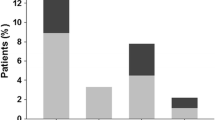Abstract
Background
Hepatitis E virus (HEV) infection is highly endemic in India, being the most common cause of acute hepatitis; however, no case of chronic infection has been reported. All the human isolates of HEV from India till date have belonged to genotype 1. In contrast, in non-endemic areas, genotype 3 is the most prevalent, and persistent HEV infection has been reported among solid-organ transplant recipients. Whether persistent infection occurs with genotype 1 HEV is unclear. We therefore looked for evidence of HEV infection among renal transplant recipients with elevated alanine transaminase (ALT).
Methods
Renal transplant recipients receiving immunosuppressive therapy were screened for ALT levels, irrespective of time duration since renal transplant. For those with ALT levels equal to or exceeding 50 IU/mL on at least two occasions ≥3 weeks apart, serum was tested for HEV RNA using a sensitive real-time reverse transcription polymerase chain reaction assay. For those testing positive, HEV genotyping and follow up for duration of viral persistence were planned.
Results
Of the 275 patients studied, 49 (17.8 %, 44 male, median age = 39.5 years) had elevated ALT levels (median = 62 [range = 50–477] IU/L). None of these 49 patients had detectable HEV RNA in the serum using an assay with detection sensitivity of 300 copies of RNA/mL of specimen.
Conclusion
Our data indicate that persistent HEV infection is an infrequent cause of ALT elevation in Indian renal transplant recipients who are receiving immunosuppressive drugs. This suggests that infection with genotype 1 HEV may have either no or low potential to cause persistent infection.
Similar content being viewed by others
References
Aggarwal R, Jameel S. Hepatitis E. Hepatology. 2011;54:2218–26.
Kamar N, Garrouste C, Haagsma EB, et al. Factors associated with chronic hepatitis in patients with hepatitis E virus infection who have received solid organ transplants. Gastroenterology. 2011;140:1481–9.
Bihl F, Negro F. Chronic hepatitis E in the immunosuppressed: a new source of trouble? J Hepatol. 2009;50:435–7.
Kamar N, Selves J, Mansuy JM, et al. Hepatitis E virus and chronic hepatitis in organ-transplant recipients. N Engl J Med. 2008;358:811–7.
Haagsma EB, van den Berg AP, Porte RJ, et al. Chronic hepatitis E virus infection in liver transplant recipients. Liver Transpl. 2008;14:547–53.
Neukam K, Barreiro P, Macias J, et al. Chronic hepatitis E in HIV patients: rapid progression to cirrhosis and response to oral ribavirin. Clin Infect Dis. 2013;57:465–8.
Fujiwara S, Yokokawa Y, Morino K, Hayasaka K, Kawabata M, Shimizu T. Chronic hepatitis E: a review of the literature. J Viral Hepat. 2014;21:78–89.
Arankalle VA, Paranjape S, Emerson SU, Purcell RH, Walimbe AM. Phylogenetic analysis of hepatitis E virus isolates from India (1976–1993). J Gen Virol. 1999;80(Pt 7):1691–700.
Arankalle VA, Chobe LP, Walimbe AM, Yergolkar PN, Jacob GP. Swine HEV infection in south India and phylogenetic analysis (1985–1999). J Med Virol. 2003;69:391–6.
Naik A, Gupta N, Goel D, Ippagunta SK, Sharma RK, Aggarwal R. Lack of evidence of hepatitis E virus infection among renal transplant recipients in a disease-endemic area. J Viral Hepat. 2013;20:e138–40.
Jothikumar N, Cromeans TL, Robertson BH, Meng XJ, Hill VR. A broadly reactive one-step real-time RT-PCR assay for rapid and sensitive detection of hepatitis E virus. J Virol Methods. 2006;131:65–71.
Aggarwal R, Kini D, Sofat S, Naik SR, Krawczynski K. Duration of viraemia and faecal viral excretion in acute hepatitis E. Lancet. 2000;356:1081–2.
Nanda SK, Ansari IH, Acharya SK, Jameel S, Panda SK. Protracted viremia during acute sporadic hepatitis E virus infection. Gastroenterology. 1995;108:225–30.
Peron JM, Mansuy JM, Recher C, et al. Prolonged hepatitis E in an immunocompromised patient. J Gastroenterol Hepatol. 2006;21:1223–4.
Dalton HR, Bendall RP, Keane FE, Tedder RS, Ijaz S. Persistent carriage of hepatitis E virus in patients with HIV infection. N Engl J Med. 2009;361:1025–7.
Tavitian S, Peron JM, Huynh A, et al. Hepatitis E virus excretion can be prolonged in patients with hematological malignancies. J Clin Virol. 2010;49:141–4.
Arankalle VA, Chobe LP, Joshi MV, Chadha MS, Kundu B, Walimbe AM. Human and swine hepatitis E viruses from Western India belong to different genotypes. J Hepatol. 2002;36:417–25.
Hering T, Passos AM, Perez RM, et al. Past and current hepatitis E virus infection in renal transplant patients. J Med Virol. 2014;86:948–53.
Passos AM, Heringer TP, Medina-Pestana JO, Ferraz ML, Granato CF. First report and molecular characterization of hepatitis E virus infection in renal transplant recipients in Brazil. J Med Virol. 2013;85:615–9.
Acknowledgments
The authors thank Mr. Vishwajeet Yadav and Ms. Pallavi Shukla for technical help.
Conflict of interest
SM, NG, RKS, AG, NP, AK, DB, AG, and RA all declare that they have no conflict of interest.
Ethics statement
The authors declare that the survey was performed in a manner that conforms to the Helsinki Declaration of 1975, as revised in 2000 and 2008 concerning Human and Animal Rights, and that the authors followed the policy concerning informed consent wherever applicable as shown in www.Springer.com.
Author information
Authors and Affiliations
Corresponding author
Rights and permissions
About this article
Cite this article
Munjal, S., Gupta, N., Sharma, R.K. et al. Lack of persistent hepatitis E virus infection as a cause for unexplained transaminase elevation in renal transplant recipients in India. Indian J Gastroenterol 33, 550–553 (2014). https://doi.org/10.1007/s12664-014-0508-5
Received:
Accepted:
Published:
Issue Date:
DOI: https://doi.org/10.1007/s12664-014-0508-5




